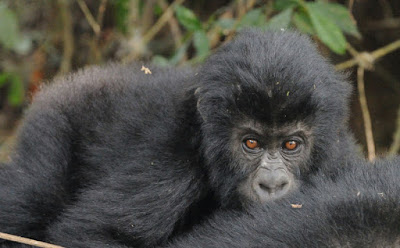 |
| A.J.Plumptre/WCS |
Weighing up to 400 pounds, Grauer’s gorillas are the heavyweight cousins of the more famous mountain gorillas, of which less than a thousand remain in the wild. It’s estimated that Grauer’s gorillas numbered up to 17,000 in the early 1990s, but experts have long feared that the ensuing civil unrest took a toll on the population. Those fears are now being confirmed. An extensive field campaign led by wildlife biologists at the WCS and Fauna & Flora International has concluded that fewer than 4,000 individuals remain—a 77 percent population decline over the course of a generation.
“Until the last three to four years, it’s been impossible to get into many of the areas where these gorillas live,” lead study author Andy Plumptre told Gizmodo over the phone. “This is the most comprehensive report to date, and it’s a lot worse than we expected.”
The trouble for Grauer’s gorillas traces back to the Rwandan genocide of 1994, which forced hundreds of thousands of refugees to flee into the DRC. This, in turn, precipitated a devastating civil war; the worst in modern African history. Nine other nations and scores of armed militia were drawn into conflict over the DRC’s vast mineral resources. Over the course of seven years, millions were killed through fighting, disease and starvation.
In addition to the human toll, the war fueled illegal hunting, logging, and the extract of precious coltan and gold ores throughout the eastern DRC’s rainforests. The emergence of a conflict mineral market—which to this day, feeds into consumer electronics through a shadowy global supply chain—spelled disaster for the country’s charismatic wildlife.
“We believe small scale mining is the main cause [of the gorilla decline],” Plumptre said. “A lot of these militia groups are going deep into the forest, partly to avoid being chased out by the military. In order to keep themselves going, they mine. And because there’s no food, they’re hunting bushmeat.”
For hunters, apes are easy targets. Unlike chimpanzees, which travel through the trees, Grauer’s gorillas move around in groups on the ground, leaving large, trackable footprints. With hordes of hungry, gun-toting humans traipsing about their forest, it’s no wonder these animals are now on the brink of disappearing.
Documenting that disappearance took hard work and nerves of steel. All in all, dozens of wildlife biologists, rangers, and community volunteers covered about 12,000 square kilometers of forest over the course of four years, searching for ground nests and other signs of the elusive apes. “We’ve had teams kidnapped by rebels, chased around the forest, shot at,” Plumptre said. “It is not an easy place to work.” Several park rangers have been killed in the effort, including most recently, one on March 31st.
If there’s a silver lining to this extremely depressing story, it’s that there’s still time to turn things around for the remaining Grauer’s gorillas. The new WCS report calls for several immediate measures, including securing the borders around existing national parks, and establishing legal boundaries around the Itombwe and Punia Gorilla Reserves, two critically important but outlying population strongholds.
Illegal mining also needs to be brought under control. That’ll require the DRC military intervention, but also, stricter international oversight to prevent conflict minerals from entering the global technology supply chain. “There’s been a process of trying to source minerals from conflict-free mining sites,” Plumptre said. “We’d like to add bushmeat-free to the criteria.”
Protecting the DRC’s remaining gorillas is not going to be easy, but the stakes have never been higher. “Unless greater investment and effort is made, we face the very real threat that this incredible primate will disappear from many parts of its range in the next five years,” study co-author Stuart Nixon said in a statement. “It’s vital that we act fast.”
0 Response to "Grauer's Gorilla Congo, Threatened By War"
Thanks for give comment.